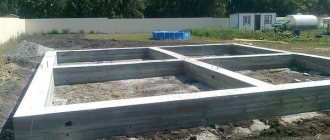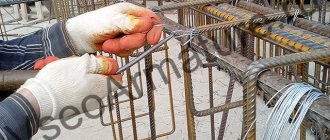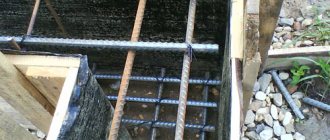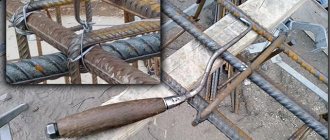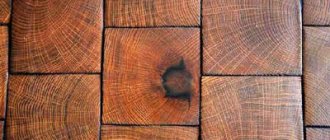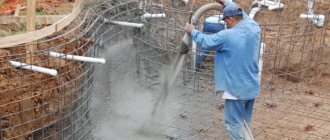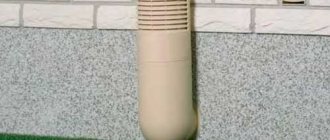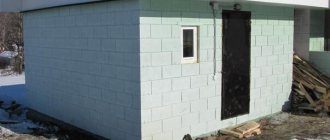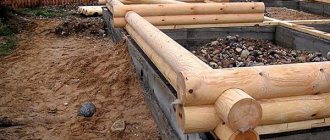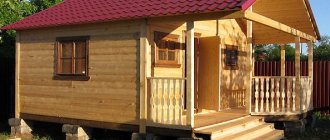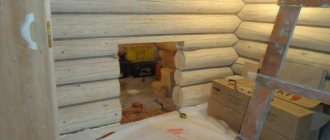The strip foundation has a non-standard geometry: its length is tens of times greater than its depth and width. Due to this design, almost all loads are distributed along the belt. A concrete stone cannot compensate for these loads on its own: its bending strength is not enough. To give a structure increased strength, not just concrete is used, but reinforced concrete - this is a concrete stone with steel elements located inside - steel reinforcement. The process of laying metal is called strip foundation reinforcement. It’s not difficult to do it with your own hands, the calculations are elementary, the diagrams are known.
The quantity, location, diameters and type of reinforcement - all this must be specified in the project. These parameters depend on many factors: both on the geological situation on the site and on the mass of the building being constructed. If you want to have a guaranteed strong foundation, you need a project. On the other hand, if you are building a small building, you can try, based on general recommendations, to do everything yourself, including designing a reinforcement scheme.
Strip foundation in private construction: features and limitations
The basis of the strip foundation is concrete. This material was widely used as a basis for the construction of buildings back in Ancient Rome. And only 200 years ago they figured out how to increase its strength using a frame made of steel rods. A new building material, reinforced concrete, combined the advantageous characteristics of metal and concrete and made it possible to build impressive structures. The process of placing a metal frame in concrete began to be called reinforcement.
When a country house is being designed, a strip foundation is most often chosen as the basis for it. The preparation of a strip base (like any other) takes 25-30% of the construction cost; the reason for its demand is a successful combination of qualities:
- Simple in design.
- Suitable for projects with basements (unlike the pile-screw analogue) and heavy floors (reinforced concrete, monolithic).
- Does not require the use of special equipment.
Strip foundation in formwork Source profundamenti.ru
Despite its wide distribution, strip foundation also has limitations in use:
- Beneficial only on dry and rocky soils.
- Not suitable for installation on problematic (wet, heaving, peaty) soil; it will have to be poured to great depth, which is unprofitable.
The shape of the strip foundation is determined by the layout; it has a closed shape and is laid along the entire perimeter of the house, under load-bearing walls and internal partitions.
Use of plastic clamps
The main advantages of this method include the speed of work completion, as well as the strength of fixation of structural elements. Using plastic clamps for knitting reinforcement also does not require special knowledge. However, plastic clamps have a certain cost and their purchase can be considered an economic cost. The disadvantages of clamps also include the fact that they can fail at low temperatures.
When analyzing these options, it can be said that the wire binding process will have a greater advantage than the same process using plastic clamps, since in the first case there will be less cost. However, clamps will help create a stronger and more reliable structure, even though it costs more money.
Prerequisites: why reinforcement is needed
The foundation is created in order to withstand the load of the structure; It works best with evenly applied pressure. But in practice, the load is too often uneven and internal stresses arise in the foundation. The reason may be both changes in the soil and design miscalculations (unequal weight of individual parts of the structure).
Design errors will definitely become noticeable Source homeklondike.site
Concrete has excellent resistance to axial compression and weak resistance to tension. Reinforcing bars have natural plasticity and compensate for the lack of concrete. The latter, in turn, protects the metal from corrosion.
During operation, concrete (which resists compression) and metal (tension) are able to most effectively resist multidirectional loads, protecting the structure from destruction. Correctly carried out reinforcement not only increases strength, but is also a means of saving: it allows you to reduce the cost of concrete (reduce the massiveness of the foundation).
Reinforcement requirements
The strip foundation is laid with a margin of safety; it must be resistant to external factors (mechanical and climatic). How to correctly knit reinforcement for a strip foundation is described in the provisions of SNiP 52-01-2003, which contain detailed requirements for design and materials. There are a number of requirements for fittings:
- The placement of the reinforcement cage should not interfere with the correct technological pouring of concrete.
- The reinforcement is installed with a given design step.
Calculation of the spacing of clamps when reinforcing a corner Source ep2nnov.ru
- At frame intersections, floating (movable) connections of rods are not allowed using any connection method.
- It is necessary to create a protective anti-corrosion layer for the structure.
- Replacing the type of load-bearing rods is allowed if the calculated load-bearing capacity remains the same.
See also: Contacts of construction companies that offer foundation repair and design services
Rules for fastening rods
According to this scheme, you can tie the reinforcement:
- The wire is tied in half.
- A hook is inserted through the loop.
- On the reverse side, the end is wrapped around the intersection and also placed in the hook.
- The wire twists.
Recommended rules and methods of work when knitting:
- The rods are pulled up, twisted, the ends are bitten off with wire cutters;
- The wire twists several turns when it is tightly stretched;
- The rods and clamps are tied.
Using paper clips, staples, clamps
If necessary, speed up the knitting using the above-mentioned materials. In these situations, knitting is done by hand without using a tool. Rods with a small diameter can be tied with self-tightening plastic clamps. Universal devices suitable for any sections. They are light, installed by hand and do not smudge. Do not forget that they have low strength and can be damaged at low temperatures.
Advantages of staples and other fasteners of the same type:
- Productivity increases;
- The density of connected nodes increases;
- Easy to use.
Materials and tools used for reinforcement
Since the reinforcement cage increases the stability of the structure by taking on a significant part of the load, its quality becomes fundamental. The frame is formed from interconnected reinforcing bars. Various are used for knitting the frame:
Types of fittings
Manufacturers offer fittings that can be divided into:
- Material of manufacture. Steel reinforcement is a classic, time-tested option; It is divided into 6 strength classes, it can be bent and welded. Composite reinforcement contains carbon, basalt, glass or aramid fibers. It is lighter, cheaper, does not corrode, does not bend and cannot be welded.
Reinforcement with a periodic profile has improved characteristics Source yar-limb.ru
- Profile. Reinforcement with a smooth profile is more often used as connecting jumpers. Reinforcement with a periodic profile has a relief surface, which improves adhesion to concrete.
Connection materials
Knitting of reinforcement for a strip foundation, the pattern of which can change, is done using:
- Knitting wire. Reliable and common knot connection technology. There are different knitting patterns.
- Threaded and crimp couplings (at mechanical joints).
- Metal paper clips. The reinforcement elements are connected without tying a knot.
- Plastic clamps and clips (fasteners). Plastic products provide simple and quick installation and are resistant to corrosion. Their use is not approved by all professionals.
Composite reinforcement bars secured with a clamp Source 1-detective.ru
- Welding. The process is fast, but the welds form a rigid connection, differ in density from the base metal and are susceptible to corrosion. When the load changes, they burst and reduce the strength of the foundation. The method is suitable for connecting rods of large diameters (in industrial facilities); To obtain a high-quality weld, you need a highly qualified welder.
What shapes are there?
The shape of the product follows the contour of the manufactured reinforced concrete product in cross section. The perimeter of the frame is slightly reduced so that when pouring, a protective layer of concrete is formed around the metal, protecting the reinforcement from corrosion.
Options for clamps in shape, depending on the geometric features of reinforced concrete structures.
Depending on the perceived load, clamps are produced in three types:
- open (“P-eshki”);
- closed (frame);
- reinforced (torsional).
Open type clamps are installed in middle beams in which bending load is predominant. The products are also used to strengthen the most loaded areas of slabs, foundations, floors, for additional reinforcement of corners, in places where windows and doors are installed.
Frames are the most common type of product that can withstand lateral loads applied in various directions. They are installed on columns, columns and beams.
An example of column reinforcement with clamps made of smooth reinforcement.
Reinforced clamps are designed for torsional loads that appear in the outer beams, as well as in foundations when supporting two floors of different types. The advantage of such products is that they provide earthquake resistance. Their ends are extended by 30 rod diameters, thereby creating a closed contour.
Requirements for reinforcement cage parameters
The rods that make up the structure differ in purpose:
- Working fittings. This is the name given to the longitudinal horizontal rods placed along the foundation strip.
- Clamps. They are divided into transverse horizontal and vertical, connecting the frame into a single whole.
The reinforcement frame of the foundation in private construction often has the following parameters:
- Fittings. Metal or composite, with a cross-section of 11-14 mm (for a small outbuilding), with a periodic profile and a cross-section of 12-18 mm (for reinforcing a strip foundation).
An example of how to knit foundation reinforcement with transverse clamps Source massimo.spb.ru
Advantages
The use of reinforcement clamps provides several advantages:
- Reducing construction costs. Manufacturing does not take much time, installation significantly reduces the final cost of the structure compared to the use of additional fittings, and increases the service life of the product.
- Simplicity and speed of installation. Using reinforcement clamps it is possible to create any spatial frames with the required parameters.
- Possibility of using clamps of any configuration and size.
- No waste during installation of products.
Video description
How to properly crochet reinforcement in the video:
Calculation of the amount of consumables for tying reinforcement
The amount of material (in linear meters) is calculated based on:
- Foundation parameters (length, width, depth)
- Reinforcement schemes (number of layers and longitudinal rods in width)
Most often, reinforcement material is sold not by linear meters, but by kilograms. There are special tables for converting values. Plastic fittings are often sold by linear meters.
Scheme of strip foundation reinforcement Source kamtehnopark.ru
How to simplify the process
If you set a goal to further simplify the knitting of reinforcing elements, you can use a power tool for this. This problem can be solved quite simply: take a regular screwdriver and insert a bent nail into the chuck. Such a simple device will allow you not only to correctly connect the reinforcement structure, but also to provide it with the required reliability.
Tying reinforcement using a special gun
There are also even more convenient methods, but their implementation will require a special tool. Such, for example, as a gun for tying reinforcement. Such equipment is quite rarely available during self-construction, but having it at hand, the process can be speeded up significantly. The convenience of such a tool is difficult to overestimate, but its cost (from 35 thousand rubles) scares off many private developers who put cost savings above speed and convenience in carrying out work on tying reinforcement.
Amateur builders can be understood, since in most cases this tool will only be needed once, and spending money on its purchase is impractical.
Reinforcement knitting pattern, corner reinforcement
The correct knitting of reinforcement for a strip foundation, optimal in many respects, is a “cage” connection of the reinforcing frame rods. In this case, the rows are secured with wire (or other chosen method) at an angle of 90°. The knitting pattern consists of several sequential operations:
- A fragment 25-30 cm long is cut from a coil of knitting wire (for rods with a cross-section of 8-16 mm).
- The wire is bent in half and placed under the overlap of the rods, placing it diagonally.
- The hook is hooked onto the loop (the place where the wire is bent), the opposite end of the wire is circled over the intersection of the rods and placed above the hook.
- By rotating the hook around the upper end of the wire, a twist of 3-4 turns is created.
- The hook is removed, the ends of the wire are bent inside the structure.
Video description
About the intricacies of reinforcement in the video:
The corners of a strip foundation cannot be reinforced by simply overlapping the rods; This is considered a gross violation of technology. To reinforce the corners and connect adjacent linear elements with them, bent rods are used; the corner fragment is reinforced with L-shaped or U-shaped anchors.
Rods laid at the corners of a building without bending, at right angles, are unable to create a rigid structure. Such sections of the foundation are highly likely to be subject to destruction in the future.
Reinforcement of corners requires compliance with technology Source zen.yandex.ru
Reinforcement technology: execution order and features of the stages
The frame for the future foundation is calculated and installed based on the dimensions of the trench, using working reinforcement and auxiliary wire. Its parameters are calculated in advance, taking into account the expected load; It is convenient to assemble the structure on a long workbench. Installation of fittings takes place in stages:
- Vertical elements (clamps) are assembled. The vertical position of the rods is checked using a plumb line.
- The lower horizontal belt is mounted. The lower belt works to deflect the foundation downwards. It is attached with a knitting wire to vertical clamps.
- The upper horizontal belt is mounted. Its task is to resist the upward bending of the foundation strip.
- Corner elements are mounted. They need to be given special attention because they connect the sides of the foundation. Additional rigidity is provided by additional vertical posts, which are laid twice as often.
- The formwork for the foundation is being prepared.
Installation of a linear fragment of a reinforcing frame Source beton-house.com
- The prepared reinforcing frame is being laid. During the installation process, pipes are laid between the reinforcement bars (the utility and ventilation systems will subsequently be laid through them).
- Concrete is poured. Filling is carried out in several stages, with each layer leveled (manually or with a vibrating platform). This technology ensures uniform distribution of the concrete mixture.
- The foundation is being waterproofed. After the concrete has dried, the foundation strip is covered with bitumen mastic or roofing felt. This operation is an important measure to preserve the foundation.
If the frame is assembled in a trench, rods are first driven into the ground, observing the calculated distances. Transverse jumpers, lower and upper reinforcing belts are fixed to them.
